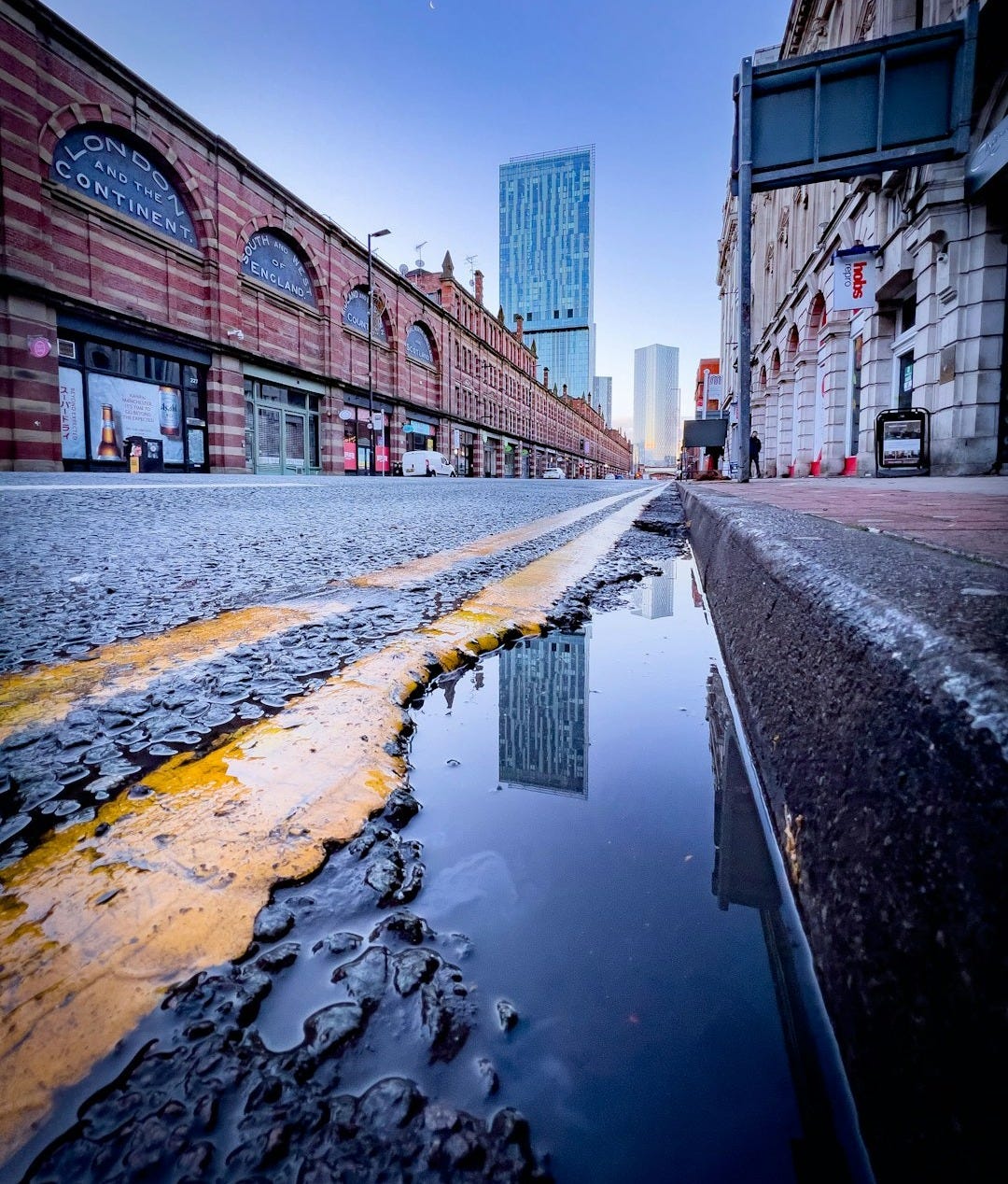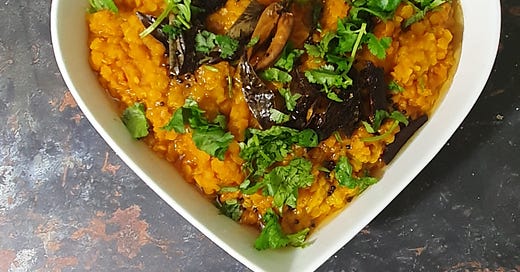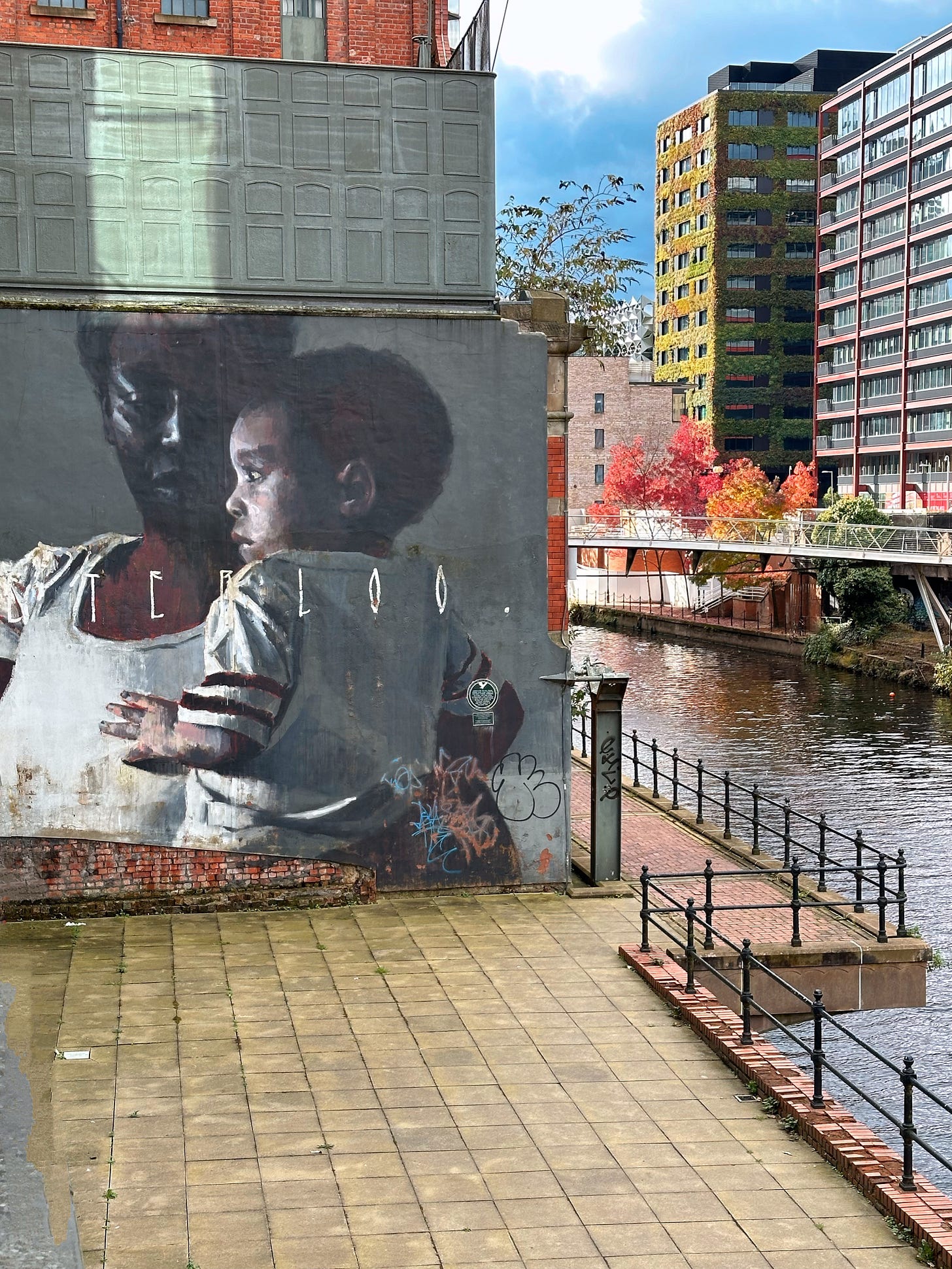Curries, Goldschläger, & Comfort Zones
Tadka-dall - Plant-based, gluten, dairy, soy, egg, nut-free
In this publication I want to celebrate other cooks/chefs and recipes that make cooking for food intolerances easy. This post contains a recipe which is reproduced with permission from Mina at Give Me Some Spice.
When it was time to head to university, my nan and her boyfriend drove me to an imposing, red-bricked Victorian halls of residence in Manchester, which I would call home for the next year.
After a stressful detour getting lost in Moss Side, we finally turned onto the road leading to my new home. I distracted my nan from the blackened, burnt-out car but couldn’t stop her from noticing the four sleeveless women waiting next to the road. My nan remarked that they needed coats and would have better luck catching a bus at the bus stop. (They weren’t waiting for a bus.)
Everything felt different—edgier. I felt my shoulders tense up. I was definitely out of my small-town comfort zone.

After we had unloaded the car, my grandparents hid some homemade alcohol—wine, schnapps, and Goldschläger—in my wardrobe, advising me to use it to make friends. They hugged me, then left.
Everything felt scary and different. New people, communal toilets and showers, and cooking for myself when I didn’t even know how to cook.
This was the early 90s. As a vegetarian, my diet consisted mostly of carbs and cheese in various forms, and my sleepy taste buds didn’t know any better.
Thankfully, I made friends quickly—perhaps the homemade alcohol helped. Soon, I had a community that encouraged me to keep pushing out of my comfort zone, from discovering electronic music to having my first-ever curry.
Like many of the curry houses in Manchester, this one had steamed-up windows, a hint of incense in the warm, spiced air that greeted you, and faded patterned plates that had served many diners before.
I ordered saag paneer, cautiously edging out of my comfort zone by marrying my love of cheese with new flavours. Blocks of white cheese in a sea of lightly spiced spinach—a perfect choice for a beginner who had never experienced the mix of spicy, sweet, tangy, and umami sensations dancing around their mouth.
And my taste buds woke up.
Soon, I was regularly waving to the ladies—who still hadn’t found their coats—on my way to uni and my regular nights out, which now included a mix of dancing and curry, both of which I couldn’t get enough of. I quickly grew to love Manchester, its food, and all its edginess.
My love of curry stayed with me over the years, and in 2001, I got a job working in India. It was a dream for a vegetarian who shouldn’t eat gluten, as I encountered flavours I’d never experienced before. Noticing my passion, my lovely team even gifted me an authentic Indian cookbook as a leaving present.
However, when I tried cooking from the book, I suddenly found myself back outside my comfort zone. The 10–15 spices I needed to grind before even starting a recipe felt overwhelming. Although I had grown more comfortable with my intolerances and improved my cooking skills, Indian food still felt out of reach.
It wasn’t until last year, when I stepped outside my comfort zone again and took the lovely Mina’s Indian cookery course, that I realised Indian food didn’t need to be difficult to be delicious.
Mina showed me how to make a plant-based balti, gluten-free paratha, and a few other dishes. I was reminded that Indian cuisine works brilliantly for those with multiple food intolerances—ghee can be replaced with vegetable ghee or oil, and most main dishes don’t contain gluten.
I’m thrilled to share Mina’s tadka-dall recipe here with her permission. It has a tangy twist from tomatoes and lemon juice, reflecting her Indian and East African heritage. It’s perfect on its own with a plate of rice or as part of a bigger meal. It can be batch-cooked easily and frozen, and it suits gluten, dairy, egg, nut, and soy-free diets.
I’ve also included one of the first videos I ever made below (so be kind!) of Mina teaching me how to cook dall. (There’s no sound as I wasn’t sure of what Substack allows you to use re music.)
If you’d like to follow Mina, you can find her here
She’s lovely, amazing, also runs workshops online and face to face and makes pretty incredible food too!
Let me know how you get on!
Ingredients for Tadka Dall:
• 1.5 cups dall ( we used Masoor ki dall – often called the pink lentils)
• 1.5 cups of tinned tomatoes (crushed) or passata
• 1 teaspoon salt
• 1 teaspoon turmeric
• 3 green chillies – chopped (use less if you are not keen on hot food)
• 1 tablespoon brown sugar or jaggery or sugar substitute
• 1 tablespoon lemon juice
• 1 teaspoon garlic paste
• 1 teaspoon ginger paste
• Small bunch of coriander
• 2 tablespoons sunflower oil
• 1 teaspoon dried cumin seeds
• Dry red chillies (optional)
• 1 or 2 pieces of cloves and cinnamon (optional)
• pinch of asafoetida (optional)
Method:
1. Wash the lentils then soak for at least 10 minutes. The longer you soak them the quicker they cooks.
2. Drain the water and add the salt, turmeric, ginger, garlic and green chillies and stir. Add in the sugar or sugar substitute. Add two and half cups of water to the dall.
3. Let the dall cook gently until it gets soft. (should take 10-15 minutes).
4. Add the tomatoes, fresh coriander and lemon juice and let it cook for 5 minutes. (Note: It will take longer if using fresh tomatoes).
5. Transfer the dall to a serving dish.
Now prepare for the tadka (tempering):
6. Heat the oil. Add the cumin seeds, cinnamon, cloves, and asafoetida. Once the mustard seeds stop popping – pour this “tadka” over the dall. (this process is usually done just before serving the dall). Stir well and serve hot.








here's to your future re-explorations!